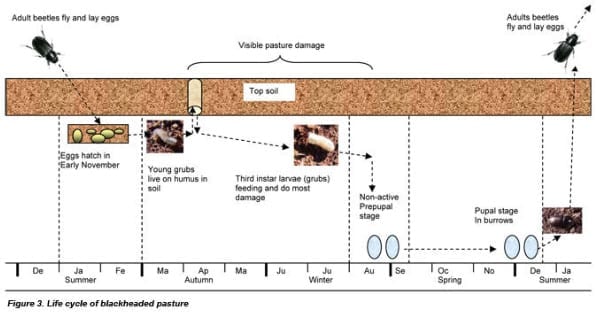At Daleys Turf, we have received quite a few calls over the past month, regarding Black Beetles in lawns. Black Beetles or African Black Beetles are also known as Cockshafers and are not a cause for concern, unless your lawn has them in plague proportions.
Black lawn beetles (Heteronychus arator) originated in Southern Africa and usually attacks kikuyu and couch varieties of lawn.
Typically, we don’t see problems with Black Beetle larvae in Sir Walter lawns, only within a couch lawn. The larvae are generally found from early spring to mid-summer and feed on the roots of the grass. The Black Beetle infestation really needs to be in plague proportion and causing severe damage to the lawn to warrant applying a spray to get rid of them. If you keep your lawn healthy with regular fertilising then you will have nothing to worry about.
You can determine the size of your infestation in a number of ways:
Observing patches of grass that dies, looks discoloured or brown for no particular reason.
Monitoring the amount of adult flight activity.
Undertaking soil sampling – 6 beetles per square metre represents a potentially damaging population.
Understanding the Black Beetle.
Larvae – the larvae live under the soil and look like a white curl grub. They are identified by their 3 pairs of legs attached to the thorax, a prominent brown head, black jaws and a swollen abdomen which is grey or blue in colour. The larvae are up to 25mm long.
Adult – the adults are found on or under the soil to a depth of 150mm. They are shiny black and a cylindrical cockchafer. Slow moving and able to fly, the adult is usually around 15mm long.
The Lifecycle.
During Spring the adults move out of their non-reproductive phase and become more active. They will feed on the stem of lawns at or just below the ground and lay eggs. These adults will die by early Summer.
By late Spring or Summer, the eggs hatch into grubs and at this time you will found larvae and adults together. The larvae then feed on organic matter and the roots of the grass until late Summer when they become pupae. Mid-summer to early Autumn sees the new adults emerge.
On warm nights during late-summer to early-autumn adults will often undertake mass flights and are particularly attracted to light. You may also see the adults during Spring, but the numbers are usually a lot lower at this time.

Treatment
Your lawn would need to be very heavily infested for any damage to be seen and most lawns will only ever have a small number of Black Beetles, which are incapable of causing significant damage. At the time of the year that the beetles are most active and eating the grass plants, your lawn is also in its growth phase, so it will quickly repair any damage caused. When the lawn goes dormant so too do the beetles.
In fact, Black Beetles may be of benefit for your lawn – as they burrow through the soil they are naturally aerating the soil for you, allowing water, oxygen and nutrients to move through the soil and reach the deep root system.

We would like to know what is the best way to treat the black beetle in our lawn. We think we have a significant problem, ranging further than 6 beetles per square metre.
Hi, Yes 6 beetles per sq metre is not good, however there are plenty of lawn insecticides to treat them. Sir Walter pest control will control them, a tub will cover 500 m2, I think it costs about $ 21.95 on our lawnstore, click this link http://thelawnstore.com.au/daleysturf/weeds-and-pest-control.html
Terry